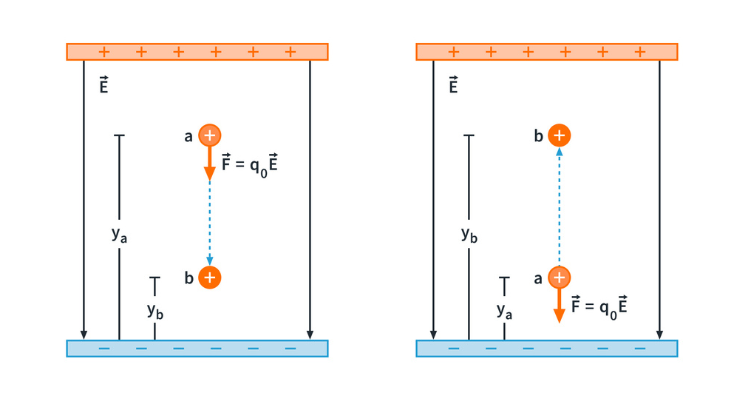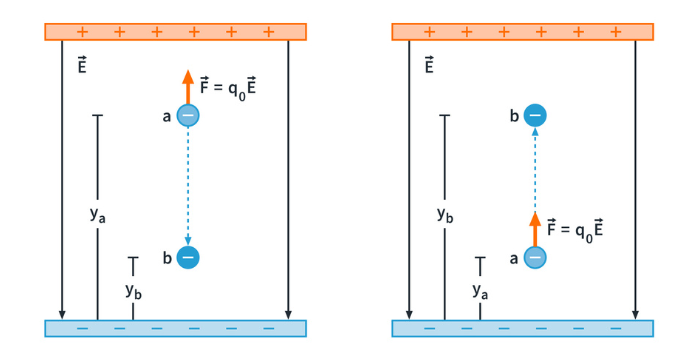What is Electric Potential? | Explanation and Examples
Published
This tutorial is all about the energy associated with electrical interactions. Every time you turn on a light or use an electronic device, you are using electrical energy, an indispensable component of our technological society. Using work and energy concepts makes it easier to solve a variety of problems in electricity. In circuits, a difference in potential from one point to another is often called voltage. Potential and voltage are crucial to understanding how electric circuits work and have equally important applications in many devices.
Electric Potential Energy
Electric field exerts force on a charged particle (
When a force 
(1)
where 









(2)




Electric Potential Energy in a Uniform Field
For an electric field that exerts a force 
(3)
Consider a positive test charge 

Figure 1: A positive charge moving (a) in the direction of 
For Fig.1 (a), the field does positive work on the test charge because the force (pointing down) is in the same direction as the net displacement of the test charge. Since 

Consider a negative test charge 


Figure 2: A negative charge moving (a) in the direction of 
For Fig.2 (a), the work is negative since the force (pointing upward) is in the opposite direction as the net displacement of the negative test charge and the potential energy increases. For Fig.2 (b), the work is positive, and the potential energy decreases.
This shows us that whether the test charge is positive or negative, the following general rules apply:
decreases if
moves in the same direction as the electric force
increases if
moves in the opposite direction as the electric force
This is the same behavior as for gravitational potential energy, which increases if a mass m moves upward (opposite the direction of the gravitational force 

When 







Electric Potential Energy of Point Charges
The idea of electric potential energy isn’t restricted to a uniform electric field. We can apply this concept to a point charge in any electric field caused by a static charge distribution. Recall that we can represent any charge distribution as a collection of point charges. It is therefore useful to calculate the work done on one test charge 


Figure 3: Test charge 

Note that the work done on 



The force on 
If 



This is also valid for general displacements a to b that do not lie on the same radial line. The work done depends only on 



The result of the integral is consistent with 






Thus, the electric potential energy of two point charges is
where 
Potential energy is defined relative to a chosen reference point where 
















We emphasize that the potential energy 








Suppose the electric field in which the charge 








Figure 4: The potential energy associated with a charge 







The total work done on 


Electric Potential
Electric potential is the electric potential energy per unit charge. The potential 


Potential energy and charge are both scalars, so the potential is a scalar. Its unit is energy divided by charge. The SI unit of potential, called the volt (V) in honor of the Italian physicist Alessandro Volta (1745–1827), is equal to 1 Joule per Coulomb:
Let’s put eq. (2), which relates the work done by the electric force during a displacement from 



We call 







The difference 













To find the potential V due to a single point charge, we substitute eq.(6) to eq.(8)
where 




The potential due to a collection of point charges is given by
The electric potential due to a collection of point charges is the scalar sum of the potentials due to each charge.
When we have a continuous distribution of charge along a line, over a surface, or through a volume, we divide the charge into elements, and the sum becomes an integral:
The potential defined by eqs. (11) and (12) is zero at points that are infinitely far away from all the charges.
The electric potential at a certain point is the potential energy that would be associated with a unit charge placed at that point. This is why potential is measured in Volts, or Joules per Coulomb. Take into account, too, that a charge does not have to be at a given point for a potential 
Electric Potential from Electric Field
In some problems in which the electric field is known or can be found easily, it is easier to determine 





If we divide this by 
where is the angle between 











This is when the limits are reversed and it has a slightly different interpretation. To move a unit charge slowly against the electric force, we must apply an external force per unit charge equal to 



Both eq. (14) and (15) also show that the unit of potential difference (1 V) is equal to the unit of electric field (1 N/C) multiplied by the unit of distance (1 m). Hence the unit of electric field can be expressed as 1 volt per meter (1 V/m) as well as (1 N/C). In practice, the volt per meter is typically the unit of electric field magnitude.
Electron Volts
The magnitude 




If charge 



This energy quantify is defined to be 1 electron volt (1 eV):
Example 1: A proton (






Determine
(a) the force on the proton
(b) the work done on the proton by the field
(c) the potential difference

Solution
This problem uses the relationship between electric field and electric force. It also uses the relationship between force, work, and potential energy difference. We are given the electric field, so we can conveniently find the electric force on the proton. 

(a) The force on the proton is in the same direction as the electric field, and its magnitude is
(b) The force is constant and in the same direction as the displacement, so the work done on the proton is
(c) From eq. (9) the potential difference is the work per unit charge, which is
We can get the same result even more easily by remembering that 1 electron volt is equal to 1 volt multiplied by the charge 



Example 2: The charges in the figure are fixed in space. Find the value of the distance x so that the electric potential energy of the system is zero.

Solution
To solve this, we simply add up all the potential energies between all pairs of charges, let their sum be 0, and solve for the corresponding 
Let 



Using eq.(6), the sum of the potential energies between all pairs of charges is
Equating to 0,
Plugging the values for 






Example 3: A point charge has 







(a) Find the potential difference 
(b) Repeat for points 

Solution: To get the potential difference, we just obtain the electric potential at both 







(a) Using eq.(10) to obtain the electric potential at both 

Getting the potential difference,
(b) Since the distances and everything else in this item are the same as that in (a), the potential difference is still 
In both figures, the point 

Example 4: A solid non-conducting sphere of radius 

Solution: The first step in solving this problem is finding an expression for the electric field outside the sphere using Gauss’s law. With this information, we can then solve for the electric potential.
To solve for the electric field, we construct a spherical Gaussian surface of radius 


We know that the total charge can be expressed as the product of the charge distribution and the total volume of the sphere, or
Recall that 

And so,
We integrate both sides, with the right-hand side integrated from 0 to 
The electric field is
We can now solve for the potential using eq. (15). We set that 





Get the latest tools and tutorials, fresh from the toaster.



















































